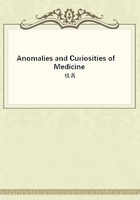
第88章
Sangalli speaks of a man of thirty-five who had a supernumerary penis, furnished with a prepuce and capable of erection. At the apex of the glans opened a canal about 12 cm. long, through which escaped monthly a serous fluid. Smith mentions a man who had two penises and two bladders, on one of which lithotomy was performed. According to Ballantyne, Taruffi, the scholarly observer of terata, mentions a child of forty-two months and height of 80 cm. who had two penises, each furnished with a urethra and well-formed scrotal sacs which were inserted in a fold of the groin. There were two testicles felt in the right scrotum and one in the left. Fecal evacuations escaped through two anal orifices. There is also another case mentioned similar to the foregoing in a man of forty; but here there was an osseous projection in the middle line behind the bladder. This patient said that erection was simultaneous in both penises, and that he had not married because of his chagrin over his deformity. Cole speaks of a child with two well-developed male organs, one to the left and the other to the right of the median line, and about 1/4or 1/2 inch apart at birth. The urethra bifurcated in the perineal region and sent a branch to each penis, and urine passed from each meatus. The scrotum was divided into three compartments by two raphes, and each compartment contained a testicle. The anus at birth was imperforate, but the child was successfully operated on, and at its sixtieth day weighed 17 pounds.
Lange says that an infant was brought to Karg for relief of anal atresia when fourteen days old. It was found to possess duplicate penises, which communicated each to its distinct half of the bladder as defined by a median fold. The scrotum was divided into three portions by two raphes, and each lateral compartment contained a fully formed testicle. This child died because of its anal malformation, which we notice is a frequent associate of malformations or duplicity of the penis. There is an example in an infant described in which there were two penises, each about 1/2 inch long, and a divided scrotal sac 21 inches long. Englisch speaks of a German of forty who possessed a double penis of the bifid type.
Ballantyne and his associates define diphallic terata as individuals provided with two more or less well-formed and more or less separate penises, who may show also other malformations of the adjoining parts and organs (e.g., septate bladder), but who are not possessed of more than two lower limbs. This definition excludes, therefore, the cases in which in addition to a double penis there is a supernumerary lower extremity--such a case, for example, as that of Jean Baptista dos Santos, so frequently described by teratologists. It also excludes the more evident double terata, and, of course, the cases of duplication of the female genital organs (double clitoris, vulva, vagina, and uterus). Although Schurig, Meckel, Himly, Taruffi, and others give bibliographic lists of diphallic terata, even in them erroneous references are common, and there is evidence to show that many cases have been duplicated under different names.
Ballantyne and Skirving have consulted all the older original references available and eliminated duplications of reports and, adhering to their original definition, have collected and described individually 20 cases; they offer the following conclusions:--1. Diphallus, or duplication of the penis in an otherwise apparently single individual, is a very rare anomaly, records of only 20 cases having been found in a fairly exhaustive search through teratologic literature. As a distinct and well-authenticated type it has only quite recently been recognized by teratologists.
2. It does not of itself interfere with intrauterine or extrauterine life; but the associated anomalies (e.g., atresia ani) may be sources of danger. If not noticed at birth, it is not usually discovered till adult life, and even then the discovery is commonly accidental.
3. With regard to the functions of the pelvic viscera, urine may be passed by both penises, by one only, or by neither. In the last instance it finds exit by an aperture in the perineum. There is reason to believe that semen may be passed in the same way;but in most of the recorded cases there has been sterility, if not inability to perform the sexual act.
4. All the degrees of duplication have been met with, from a fissure of the glans penis to the presence of two distinct penises inserted at some distance from each other in the inguinal regions.
5. The two penises are usually somewhat defective as regards prepuce, urethra, etc.; they may lie side by side, or more rarely may be situated anteroposteriorly; they may be equal in size, or less commonly one is distinctly larger than the other; and one or both may be perforate or imperforate.
6. The scrotum may be normal or split; the testicles, commonly two in number, may be normal or atrophic, descended or undescended; the prostate may be normal or imperfectly developed, as may also the vasa deferentia and vesiculae seminales.
7. The commonly associated defects are: More or less completely septate bladder, atresia ani, or more rarely double anus, double urethra, increased breadth of the bony pelvis with defect of the symphysis pubis, and possibly duplication of the lower end of the spine, and hernia of some of the abdominal contents into a perineal pouch. Much more rarely, duplication of the heart, lungs, stomach, and kidneys has been noted, and the lower limbs may be shorter than normal.